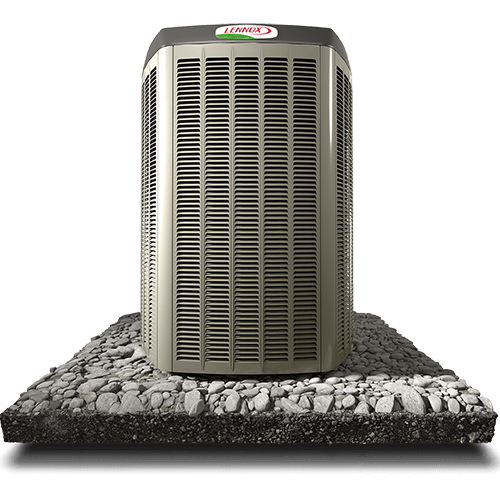
Central air conditioning has become a staple for many homeowners who enjoy the comfort that it brings during the hot summer months. While there are many appliances that you may never know the inner workings of, your air conditioning system shouldn’t be one of them. When you have a general understanding of how your air conditioning system works, you can better assess problems and perform necessary maintenance.
A General Understanding
Most people think of an air conditioning system as a cooling system. While it does help to reduce the temperature in your home, it doesn’t actually cool the air. Instead, your air conditioner works to transfer heat and humidity from the air indoors to the outdoors. Therefore, it’s crucial to shift your view of an air conditioner from a cooling system to a heat and humidity transfer system.
The Main Components of Your AC System
Before we jump into explaining how each part of your air conditioning system works, it’s important for you to understand the parts that go into it. There are five main components in your system. These are the indoor unit, outdoor unit, thermostat, ductwork, and refrigerant. Each component plays a unique role in transferring heat and humidity outdoors.
It All Starts With the Thermostat
The most essential part of your home air conditioning system is your thermostat. This is the brain of the system that tells the other components when to turn on and off. Your thermostat is placed on the main level somewhere near the middle of your home. This positioning allows it to determine the ambient temperature of the interior air in your home.
Your thermostat can be programmed to a specific temperature, such as 78 degrees. Whenever the thermostat reads a temperature that is above 78 degrees, it will tell the remaining system components to kick on. When your thermostat senses that your indoor temperature is 78 degrees, it will signal for the remaining components to turn off.
Understanding the Indoor Unit
Your indoor air conditioning unit is what draws the heat and humidity out of the air in your home. Many people don’t realize that humidity can make a room feel much hotter than it actually is. Therefore, for an air conditioning unit to be effective at making your family feel cooler, it must remove the humidity as well as the heat from the indoor air.
When your thermostat senses that the indoor air temperature is above the desired temperature, it will kick on the entire system. This starts with the fan inside of the indoor unit forcing air from the return ducts into your indoor unit. The air will pass through the air filter to remove dust, pollen, and other airborne allergens.
The Importance of Air Filters
Most homeowners are aware of the fact that their air conditioning systems have a filter or two. While it’s recommended that you change this filter every three months, you may lapse on doing so. It may have just slipped your mind, or you may think it’s not particularly important.
The reality is that your air filter is responsible for the quality of the air that you have in your home. A quality air filter can remove unwanted allergens and dust from your air so that your family isn’t inhaling the polluted air. Your family spends a lot of time indoors, so having good indoor air quality is necessary. This is an especially crucial component for those with nasty allergies and young children.
Your air conditioning filter also plays a role in the efficiency of your overall system. If the air filter is clogged up with debris, your air conditioning system will have to work harder to force air through the filter. This can result in skyrocketing power bills. You should check your air filter every few months and replace it if you can’t see through it.
Refrigerant’s Role in Your AC System
Once filtered, the hot air passes over the evaporator coil. Inside of the coil is a substance called refrigerant. This refrigerant is initially in a liquid state and will turn into a gaseous state when joined with heat from the air. As the heat leaves the air that is passing over the evaporator coil, it’s cooled.
During this process, excess moisture from the air is removed into the drain pan, which is underneath the evaporator coil. The cooled air is then blown by the fan back through the supply ductwork to the various rooms inside of your home. The now gaseous refrigerant is transferred via copper tubing to the outdoor unit.
Dispersing the Unwanted Heat
When the refrigerant arrives at the outdoor unit, it passes into the compressor inside of the unit. The compressor’s job is to pressurize the refrigerant gas and to send it to the condenser coil, which is also in the outside unit. A large fan inside of the outdoor unit works to pull outside air through the condenser coil.
The outdoor air passing through the coil works to absorb the heat energy in the refrigerant. The heated air gets dispersed into the outdoor environment. The refrigerant converts back into a liquid when it loses its heat energy. The liquid refrigerant is then piped back into your home via insulated copper tubing.
As the liquid refrigerant passes indoors through the insulated copper tubing, it will enter an expansion device. This device works to regulate the amount of liquid refrigerant that can freely flow into the evaporator coil. Once the refrigerant enters the evaporator coil, the whole heat transfer process happens all over again. Your system will continue this process until the thermostat reads that the temperature is at the appropriate level.
Different Types of Home Air Conditioning Systems
There are three main types of air conditioning systems that you can have installed in your home. These include split, packaged, and ductless systems. Most homes have a split system air conditioner. This means that the air conditioning components are separate from the heating components in your home.
Packaged systems, on the other hand, combine both cooling and heating into one single unit. These systems are common for homes that don’t have adequate space to install a separate heating unit, such as a furnace.
Lastly, we have ductless air conditioning systems. Ductless systems are typically reserved for already constructed homes that have no existing ductwork. These systems have an individual wall-mounted unit in each main room of your home that is connected via copper tubing to an outdoor compressor unit. Ductless systems have the added benefit of zone heating and cooling. This means you can set your kitchen unit to 75 degrees and your bedroom unit to 78 degrees.
Trusted AC Services
Getting AC services from a trusted contractor in San Antonio, TX, is as easy as calling Beyer Air Conditioning & Heating. Our skilled technicians specialize in cooling, heating, ductwork, and indoor air quality installation, maintenance, and repair services. Give us a call today to get started on your project.



